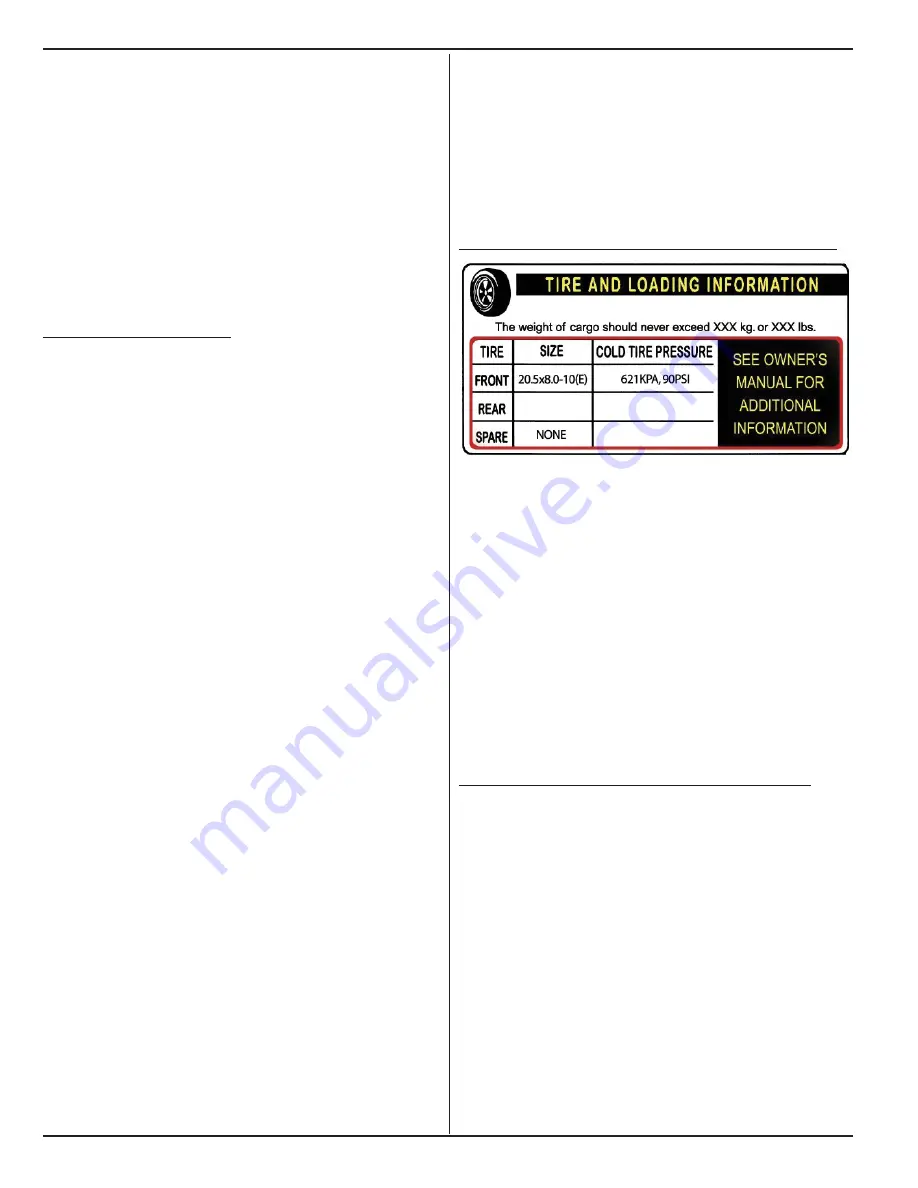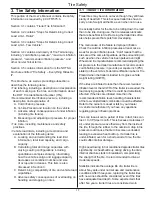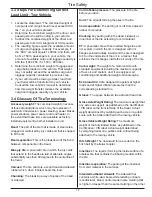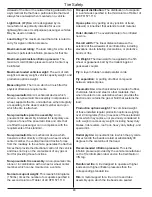
18
occurs. This situation can generate an excessive
amount of heat within the tire. Excessive heat may
lead to tire failure. It is the air pressure that enables
a tire to support the load, so proper infl ation is
critical. The proper air pressure may be found on the
Certifi cation / VIN label and/or on the Tire Placard.
This value should never exceed the maximum cold
infl ation pressure stamped on the tire.
3.2.1 Trailers 10,000 Pounds GVWR Or Less
1.
Locate the statement, “The weight of cargo should
never exceed XXX kg or XXX lbs.,” on your
vehicle’s placard.
2.
This fi gure equals the available amount of cargo
and luggage load capacity.
3.
Determine the combined weight of luggage and
cargo being loaded on the vehicle. That weight
may not safely exceed the available cargo and
luggage load capacity.
4.
The trailer’s placard refers to the Tire Information
Placard attached adjacent to or near the trailer’s
VIN (Certifi cation) label at the left front of the
trailer.
3.2.2 Trailers Over 10,000 Pounds GVWR
(Note: These trailers are not required to have a tire
information placard on the trailer and may not have
one installed)
1.
Determine the empty weight of your trailer by
weighing the trailer using a public scale or other
means.
2.
Locate the GVWR (Gross Vehicle Weight Rating)
of the trailer on your trailer’s VIN (Certifi cation)
label.
3.
Subtract the empty weight of your trailer from
the GVWR stated on the VIN label. That weight
is the maximum available cargo capacity of the
trailer and may not be safely exceeded. Safety
Administration (NHTSA) in addition to notifying us.
out and should be replaced, even if they have had
minimal or no use. This is such a general statement
that it may not apply in all cases. It is best to have
your tires inspected by a tire supplier to determine if
your tires need to be replaced.
If you are storing your trailer for an extended period,
make sure the tires are fully infl ated to the maximum
rated pressure and that you store them in a cool, dry
place, such as a garage. Use tire covers to protect the
trailer tires from the harsh effects of the sun.
3.2 Steps For Determining Correct
Load Limit - Trailer
Determining the load limits of a trailer includes more
than understanding the load limits of the tires alone.
On all trailers there is a Federal Certifi cation / VIN
label that is located on the forward half of the left
(road) side of the unit. This certifi cation/VIN label will
indicate the trailer’s Gross Vehicle Weight Rating
(GVWR). This is the most weight the fully loaded
trailer can weigh. It will also provide the Gross Axle
Weight Rating (GAWR). This is the most a particular
axle can weigh. If there are multiple axles, the GAWR
of each axle will be provided.
If your trailer has a GVWR of 10,000 pounds or
less, there is a vehicle placard located in the same
location as the certifi cation label described above.
This placard provides tire and loading information. In
addition, this placard will show a statement regarding
maximum cargo capacity.
Cargo can be added to the trailer, up to the maximum
weight specifi ed on the placard. The combined weight
of the cargo is provided as a single number. In any
case, remember: the total weight of a fully loaded
trailer can not exceed the stated GVWR.
When loading your cargo, be sure it is distributed
evenly to prevent overloading front to back and side
to side. Heavy items should be placed low and as
close to the axle positions as reasonable. Too many
items on one side may overload a tire. The best way
to know the actual weight of the vehicle is to weigh
it at a public scale. Talk to your dealer to discuss the
weighing methods needed to capture the various
weights related to the trailer. This would include the
weight empty or unloaded, weights per axle, wheel,
hitch or king-pin, and total weight.
Excessive loads and/or under infl ation cause tire
overloading and, as a result, normal tire fl exing
Tire Safety
Summary of Contents for Utility Trailer
Page 14: ...14 Safety ...
Page 52: ...52 ...
















































